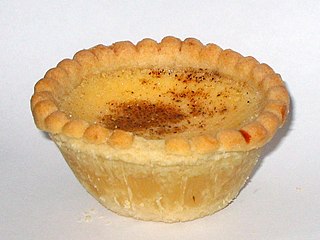
Baking is a method of preparing food that uses dry heat, typically in an oven, but can also be done in hot ashes, or on hot stones. The most common baked item is bread, but many other types of foods can be baked. Heat is gradually transferred "from the surface of cakes, cookies, and pieces of bread to their center. As heat travels through, it transforms batters and doughs into baked goods and more with a firm dry crust and a softer center". Baking can be combined with grilling to produce a hybrid barbecue variant by using both methods simultaneously, or one after the other. Baking is related to barbecuing because the concept of the masonry oven is similar to that of a smoke pit.

Pastry is baked food made with a dough of flour, water and shortening that may be savoury or sweetened. Sweetened pastries are often described as bakers' confectionery. The word "pastries" suggests many kinds of baked products made from ingredients such as flour, sugar, milk, butter, shortening, baking powder, and eggs. Small tarts and other sweet baked products are called pastries as a synecdoche. Common pastry dishes include pies, tarts, quiches, croissants, and pasties.

A pie is a baked dish which is usually made of a pastry dough casing that contains a filling of various sweet or savoury ingredients. Sweet pies may be filled with fruit, nuts, brown sugar, sweetened vegetables, or with thicker fillings based on eggs and dairy. Savoury pies may be filled with meat, eggs and cheese (quiche) or a mixture of meat and vegetables.

An apple pie is a fruit pie in which the principal filling ingredient is apples. The earliest printed recipe is from England. Apple pie is often served with whipped cream, ice cream, or cheddar cheese. It is generally double-crusted, with pastry both above and below the filling; the upper crust may be solid or latticed. The bottom crust may be baked separately ("blind") to prevent it from getting soggy. Deep-dish apple pie often has a top crust only. Tarte Tatin is baked with the crust on top, but served with it on the bottom.

A mooncake is a Chinese bakery product traditionally eaten during the Mid-Autumn Festival (中秋節). The festival is about lunar appreciation and Moon watching, and mooncakes are regarded as a delicacy. Mooncakes are offered between friends or on family gatherings while celebrating the festival. The Mid-Autumn Festival is widely regarded as one of the four most important Chinese festivals.

A pork pie is a traditional English meat pie, usually served either at room temperature or cold. It consists of a filling of roughly chopped pork and pork fat, surrounded by a layer of jellied pork stock in a hot water crust pastry. It is normally eaten as a snack or with a salad.

Hot water crust is a type of pastry used for savory pies, such as pork pies, game pies and, more rarely, steak and kidney pies. Hot water crust is traditionally used for producing hand-made pies.

A Scotch pie or mutton pie is a small, double-crust meat pie, traditionally filled with minced mutton but now generally beef, sometimes lamb. It may also be known as a shell pie or mince pie to differentiate it from other varieties of savoury pie, such as the steak pie, steak and kidney pie, steak-and-tattie (potato) pie, and so forth. The Scotch pie originated in Scotland, where it is simply called "a pie" but can be found in other parts of the United Kingdom, and is widely sold all over Canada. They are often sold alongside other types of hot food in football grounds, traditionally accompanied by a drink of Bovril, resulting in the occasional reference to football pies.

In baking, a crust is the outer, hard skin of bread or the shell of a pie. Generally, it is made up of at least shortening or another fat, water, flour, and salt. It may also include milk, sugar, or other ingredients that contribute to the taste or texture. An egg or milk wash can be used to decorate the outside, as well as coarse sugar. A crust contributes to a pastry.

Börek or burek are a family of pastries or pies found in the Balkans, Middle East and Central Asia. The pastry is made of a thin flaky dough such as filo with a variety of fillings, such as meat, cheese, spinach or potatoes. Boreks are mainly associated with Anatolia, the Middle East, Armenia, and also with the former Ottoman Empire, including the Balkans and the South Caucasus, Eastern European and Central European countries, Northern Africa and Central Asia. A borek may be prepared in a large pan and cut into portions after baking, or as individual pastries. They are usually baked but some varieties can be fried. Borek is sometimes sprinkled with sesame or nigella seeds, and it can be served hot or cold.

Bakpia or Hopia is a popular Indonesian and Philippine bean-filled moon cake-like pastry originally introduced by Fujianese immigrants in the urban centers of both nations around the turn of the twentieth century. It is a widely available inexpensive treat and a favoured gift for families, friends and relatives.
Bosnia and Herzegovina cuisine is balanced between Western and Eastern influences. The food is closely related to former Yugoslav, Middle Eastern, Mediterranean, Austo-Hungarian and other Balkan cuisines.

The Bedfordshire clanger is a dish from Bedfordshire and adjacent counties in England, such as Buckinghamshire and Hertfordshire. It dates back to at least the 19th century. It is still available at various bakers and served at some cafes, restaurants and local places of interest.

Custard tarts or flans pâtissier are a baked pastry consisting of an outer pastry crust filled with egg custard.

A meat pie is a pie with a filling of meat and often with other savory ingredients. They are found in cuisines worldwide.

A lemon tart is a dessert dish, a variety of tart. It has a pastry shell with a lemon flavored filling.
Pastel is the Spanish and Portuguese word for pastry, a sugary food, and is the name given to different typical dishes of various countries where those languages are spoken. In Mexico, pastel typically means cake, as with Pastel de tres leches. However, in different Latin American countries pastel can refer to very different sugary dishes, and even to non-sugary ones as well. In some places, like Brazil, a pastel can refer to both a sugary and non-sugary food, depending on the filling used.

Buko pie, sometimes anglicized as coconut pie, is a traditional Filipino baked young coconut (malauhog) custard pie. It is considered a specialty in the city of Los Baños, Laguna located on the island of Luzon.
Huff paste is a cooking technique involving making a stiff pie shell using a mixture of flour, suet, and boiling water. The pastry when cooked creates a tough protective layer around the food inside. When cooked, the pastry is generally discarded as it is virtually inedible. However, the shell becomes soaked with the meat juices and historically was sometimes eaten by house servants after the meal had concluded.
Pie in American cuisine has roots in English cuisine and has evolved over centuries to adapt to American cultural tastes and ingredients. The creation of flaky pie crust shortened with lard is credited to American innovation.

















